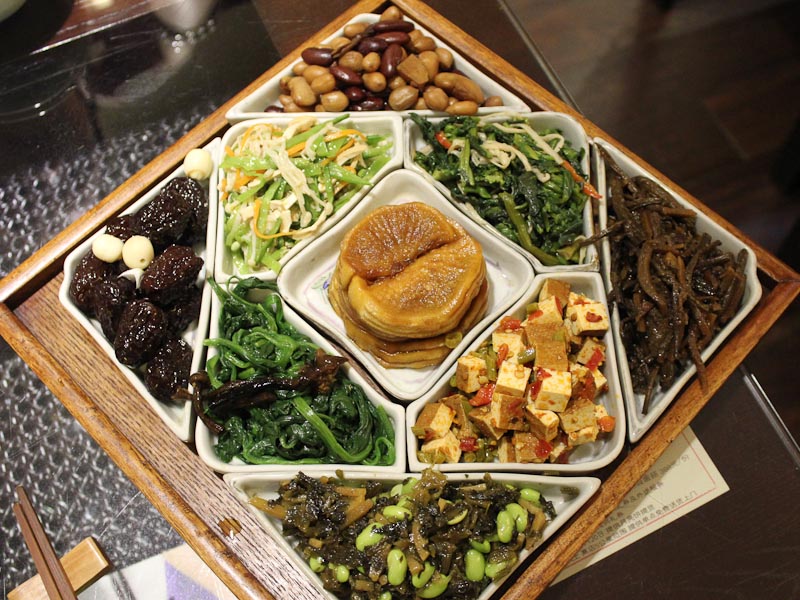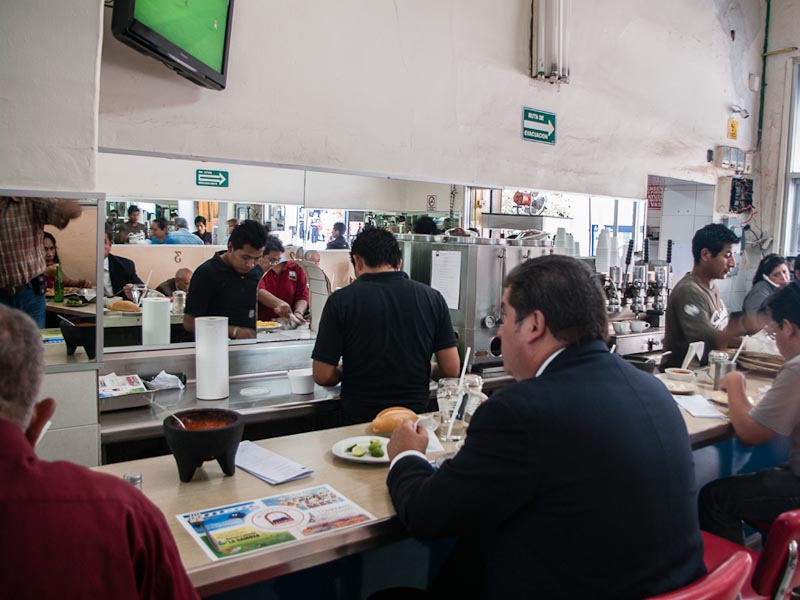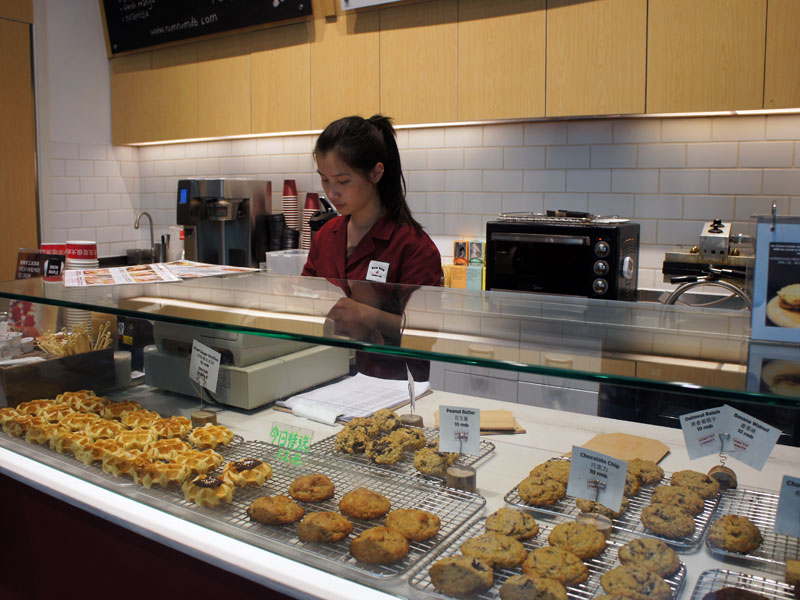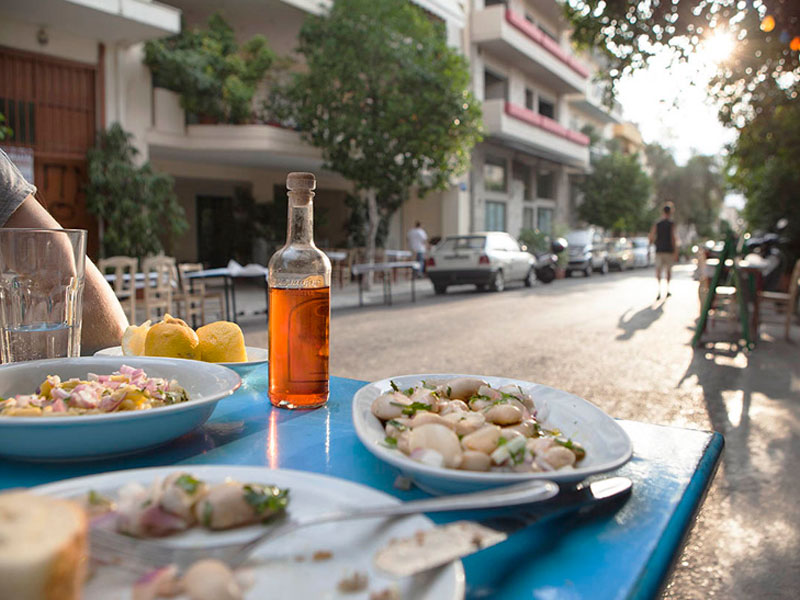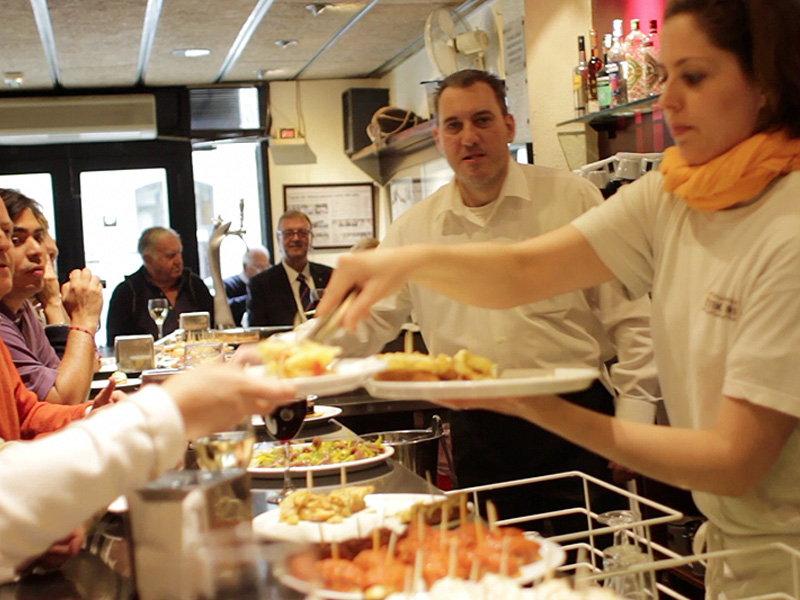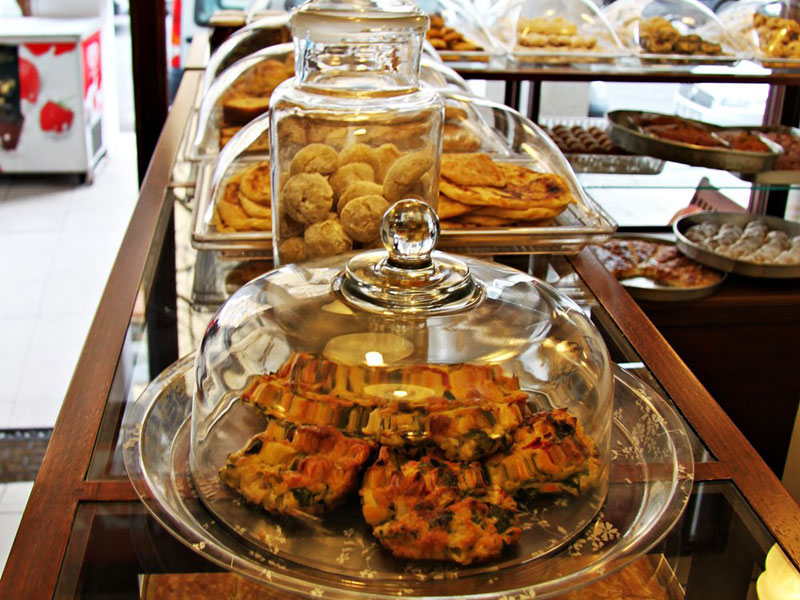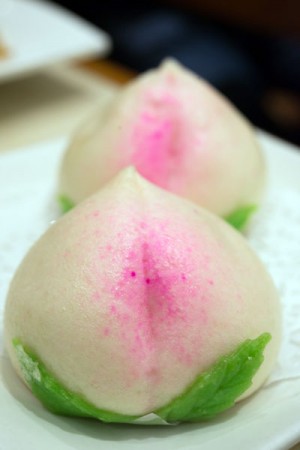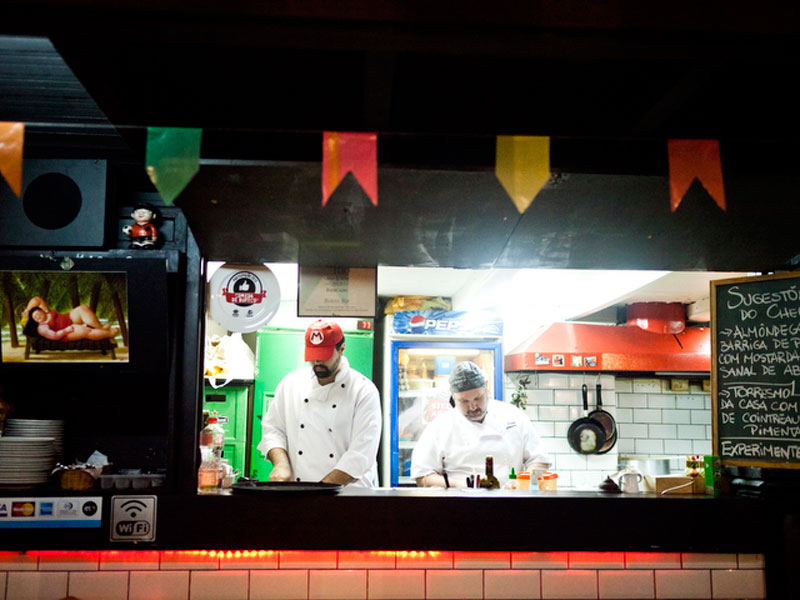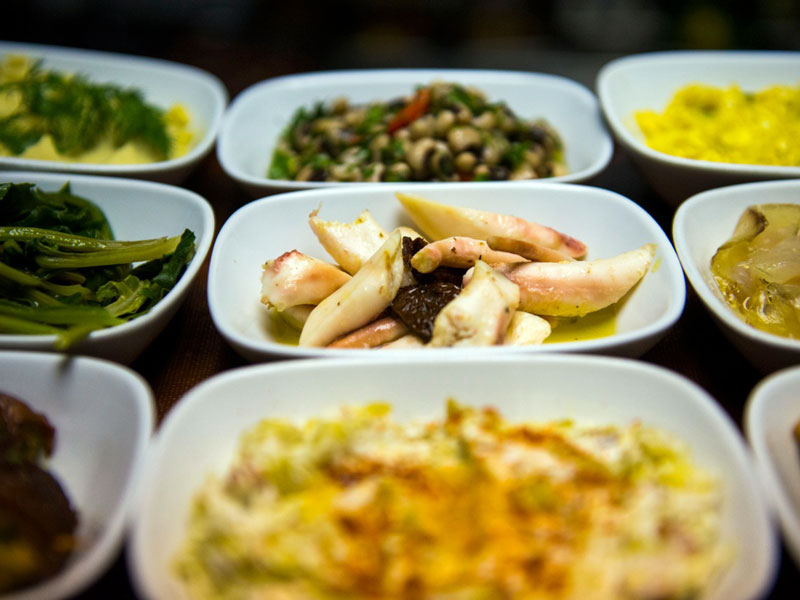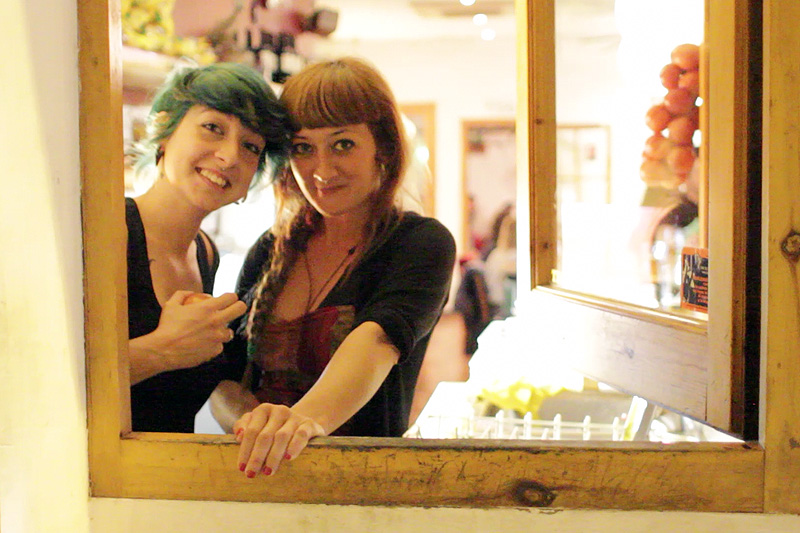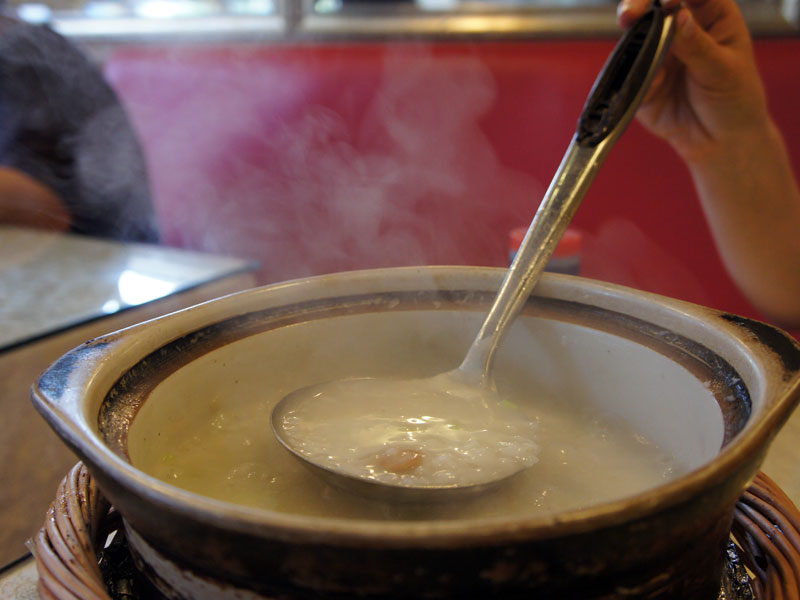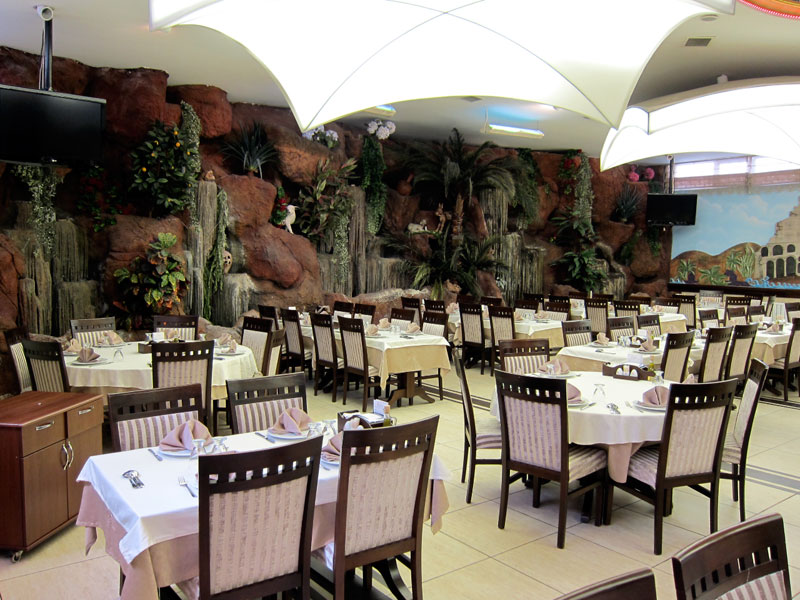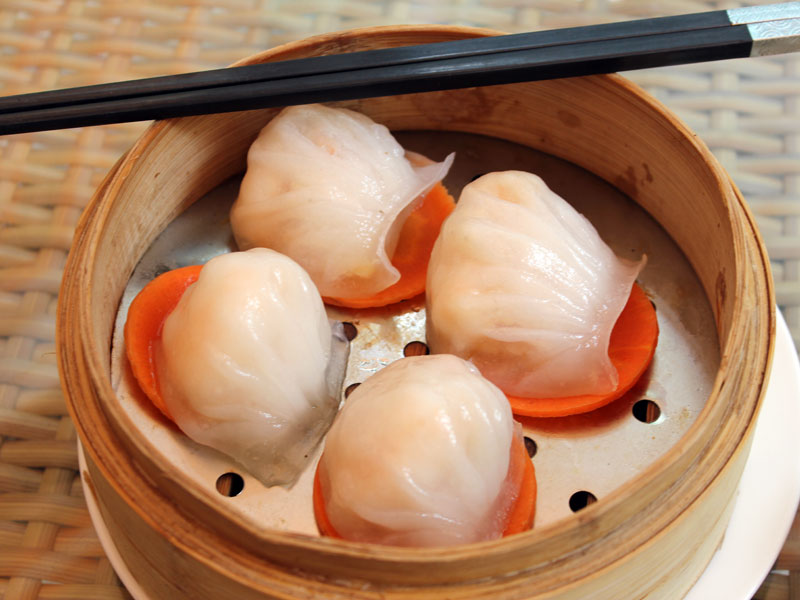We can't find the internet
Attempting to reconnect
Something went wrong!
Hang in there while we get back on track
Search results for
Shanghai
Wu Guan Tang: The Monastic Cafeteria
Dining at Buddhist temples in China can be a disappointing experience. Too often, these halls of worship have been turned into tourist traps that solicit enough donations to keep the monks in expensive trainers, meat-based meals and high-end smart phones. Independent Buddhist restaurants, like Wu Guan Tang (五观堂), are a breath of fresh air, maintaining the tenets of the religion while offering quality vegetarian food in a peaceful environment.
Read moreRio
Fat Choi: Colonial Kitchen
Editor's Note: Sadly, this spot is now closed. Just inside the entrance of Fat Choi hangs a meter-tall photo of a many-armed statue of Guanyin, the Buddhist Goddess of Mercy. Iana, the daughter of Fat Choi’s founder, Silvana Assumpção, took the photo in a hotel in Macao, the infamous Chinese port and sin city. She then photoshopped out the hotel scene in the background and added bright fluffy white clouds. Macao hotels show up in posters elsewhere in the restaurant, along with a backlit aquarium with choose-your-own tilapia.
Read moreIstanbul
Mirza Köftecisi: Meatballs in Exile
In 1922, reporting for the Toronto Daily Star from the borderlands of the Thrace region, Ernest Hemingway wrote of a “Silent, Ghastly Procession” of Christian refugees fleeing the advance of “the Turk.” The literature and art of the Christian Anatolians exiled in this period – from the films of Angelopoulos to the genre of Rembetiko music itself – is considerable and no doubt strengthens the identity of this diaspora today.
Read moreBarcelona
Lukumas: Glazed and Infused
The first thing we noticed about Lukumas, a well-loved Greek doughnut shop in Gràcia, was its creative graphic identity. That should come as no surprise given that Petros Paschalidis, who opened the place in 2010, is in fact a graphic designer. He designed its stylish interior as well as Lukumas’s logo, a rendering of a paunchy, mustachioed vendor peddling lukumas, traditional Greek round sugar doughnuts.
Read moreMexico City
La Corte: Court of Appeal
Walking into La Corte is like stepping into the 1950s. At this no-frills fonda, located in downtown Mexico City by the Supreme Court (hence the name), customers perch on red vinyl seats at laminate tabletops or along the counter and read their newspapers, the tableware and lighting are utilitarian, and the décor is minimal: just a few televisions with fútbol on and the sound off. The color flat screens might be the only indication that this is, indeed, the 21st century.
Read moreBarcelona
La Biblioteca Gourmande: The Tomato Whisperer
[Editor's note: We're sorry to report that La Biblioteca Gourmande has closed.] In the heart of El Raval, one of Barcelona’s most multicultural neighborhoods, lies a portal to the Catalan countryside. At La Biblioteca, which opened in 2012, the origins of the ingredients sing out clearly from each dish and plunge you into a pure culinary experience inspired by the land: the traditional farmhouses called masias, the rustic recipes of the Pyrenees, the perfume of the valleys and gardens, the modern farmers near the city and the influence on plants and herbs of the Mediterranean Sea.
Read moreAthens
Ask CB: Child-Friendly Dining in Athens?
Dear Culinary Backstreets, My family is traveling to Athens in October. Some of our friends have told us that Athens is not very child-friendly and that the only places that cater to children are international fast food chains. Is this true? Are there any other options for those of us who do not want to eat American-style fast food?
Read moreMexico City
Tacomix: Pit(less) Bosses
Making mixiote takes some effort. On its home turf in Central Mexico, the dish is made by taking chicken, beef or mutton that is seasoned with pasilla and guajillo chili peppers as well as flavorings like thyme, cumin, bay leaves, oregano, onion and garlic, wrapping it in individual portions in maguey leaves and then slow-cooking the bundle in a pit, preferably overnight. But how about in Mexico City, a crowded metropolis where it’s not always possible to build a BBQ pit in the ground, or to obtain maguey leaves, which are both expensive and difficult to work with?
Read moreIstanbul
Perşembe Pazarı: The Nuts & Bolts of Eating in Istanbul's Hardware District
Editor’s note: We regret to report that Mutfak Dili has closed. More so than any other district in Istanbul, Perşembe Pazarı – the city’s hardware zone – brings together what we love most about this city: thriving street life, hard-to-grasp commercial enterprises, remnants of history and, of course, excellent hidden spots to eat. A chickpea and pilaf cart is pushed past a classic grilled fish dive into the rutted courtyard of an Ottoman-era han where nothing but springs are sold, hanging like heavy vines from pegboards outside tiny domed shops – that’s a typical Perşembe Pazarı moment.
Read moreMexico City
Ask CB: What Are Aguas Frescas?
Dear Culinary Backstreets, I’ve heard about drinks in Mexico called “aguas frescas,” but what exactly are they? Visitors to Mexico are sure to encounter aguas frescas, a popular category of drinks that are ubiquitous at food stands and eateries around the country. These colorful beverages, whose name literally means “fresh waters,” come in a variety of different flavors depending on the main ingredient, but generally all are made by mixing a fruit juice with water and sugar.
Read moreRio
Bar do Adão: The Pastel Rainbow
Perhaps nothing epitomizes Rio de Janeiro’s hedonistic approach to cuisine more than a popular deep-fried finger food: the pastel. A bite into one of these fresh, crispy stuffed dough pockets – which range from a palm-sized crescent moon to a rectangle as big as a dinner plate – releases a blow of hot steam that envelops the diner’s face in an aromatic cloud carrying the fragrance of the decadent fillings inside.
Read moreIstanbul
Nuruosmaniye Köftecisi: Landmark Meatballs
Editor's note: We are sad to report that Nuruosmaniye Köftecisi has closed. In Istanbul, if all you have is a street address for a restaurant, you are as good as lost. It’s all about proximity to landmarks, as in “postanedeki kokoreççi” (the kokoreç vendor near the post office) or “Süleymaniye’deki kuru fasulyeciler” (the bean eateries at Süleymaniye Mosque). This is the way we’ve learned to navigate this city and we’ve even found reason to tag some places according to our own associations.
Read moreBarcelona
Horchatería Sirvent: Nectar of the Gods
Be it kvass in Russia or boza in Turkey, every nation seems to have one of their own, a locally loved drink that to most outsiders comes off as a particularly strange brew. In Spain, that drink is horchata, a unique and deliciously refreshing concoction made from chufas (tigernuts), water and sugar. Served chilled, horchata is beloved all over the peninsula.
Read moreBarcelona
El Tast de Joan Noi: Sea-to-Table Dining
Update: This spot is sadly no longer open. In Barcelona, food markets are longtime culinary institutions beloved by both neighbors and chefs. Their intense sights, smells and sounds are a wonderful, chaotic amuse-bouche that stimulates our senses without our even opening our mouths to taste any of the products being sold. But sometimes, we long for the chance to combine the multisensory experience of market shopping with the taste of great food. Although this concept can seem obvious, it’s actually not easy to find places that combine the selling of fresh products with their cooking.
Read moreShanghai
Nom Nom Dessert Bar: Cookie Monsters, Inc.
For years, expats in Shanghai complained about the lack of quality desserts in the city. Perhaps they just meant familiar desserts, as locals were more than happy to point them to delicious egg tarts, mooncakes or Taiwanese iced treats. But alas, when it came to sweets, there seemed to be a Great Wall-sized divide between East and West.
Read moreAthens
CB on the Road: Strofi, Piraeus’s Hidden Seafood Gem
It’s a long drive from Athens to Perama, the westernmost terminal of the port town of Piraeus, and the payoff is, at first sight, minimal. To the left is the port’s industrial zone – a forest of blue and orange cranes that tower over the sea. To the right is a stretch of industrial wasteland: old electricity plants, derelict factories, walls with enormous graffiti celebrating Piraeus’s very successful team, Olympiacos, and then a jumble of recently built high-rise buildings on a rocky hill. First populated in the 1920s by immigrants from Asia Minor, Istanbul and the Pontus (Black Sea) region, this suburb of Piraeus now has about 25,000 residents, most of whose livelihoods depend on the dockyards that have been here since the 1930s. Perama remains a proud, working-class neighborhood, and it is no accident that the early Greek hip-hop of the ’90s and the so-called Low Bap hip-hop genre and movement started here.
Read moreIstanbul
Yedikule: An Istanbul Neighborhood’s Bitter Harvest
Foreigners living in Istanbul often say they love the place for its history, while some say it’s the people who make it special. We find life here mystifying for the unpredictable dialogue between the two, the way 15 million or so people reconcile their daily lives with this city’s rich past. To live inside this beautiful crash course is invigorating and, at the same time, a heartbreaking experience. Where else does the elegant silhouette of migratory storks cross a skyline of construction cranes busy laying a metro tube to connect two continents, a project whose progress was stalled by the unexpected discovery of one of the richest underwater archaeological finds ever, a lost port full of ancient boats filled with age-old cargo? Walking these streets, every day we see something so fabulous that it takes our breath away, just as we spot something around the corner threatening to smash it.
Read moreRio
Ask CB: Getting Around Rio's High Prices?
Dear Culinary Backstreets, I hear that prices in Rio are Olympic-sized. How can I eat the best the city has to offer, without spending an arm and a leg? It’s true that prices in Rio aren’t what they used to be. As a recent New York Times article notes, Brazilians pay extremely high prices (particularly relative to wages) for just about everything from food to automobiles, due to both high inflation and a tax system that’s skewed in favor of consumption taxes. The high prices hurt both consumers and businesses. As NPR reported, one Italian restaurant in Sao Paulo recently went as far as taking tomatoes off its menu because the cost had shot up so much. Meanwhile, an influx of money – from the construction boom ahead of the upcoming 2014 World Cup and 2016 Summer Olympics and from the growing oil and gas sector developing off Rio’s coast – is driving up prices even further. Indeed, what’s most surprising about Rio’s priciest locales is how oversized the lines to get into them are.
Read moreWorldwide
Our Culinary Walks in the New York Times!
We are very proud to have been included in a New York Timesarticle about small group culinary tours that appears on the front page of today’s Dining section. Looking at food walks in Istanbul, Paris, Rome and a few other culinary capitals, the article hails the arrival of a new kind of guide – the “food Sherpa”:
Read moreBarcelona
Taktika Berri: Always a Party
When Julián Fernández and Carmen Erdocia moved to Barcelona in 1996, they bought an old fútbol salon in the Eixample that was named Táctica, or “tactics,” in a reference to Spanish football. Julián and Carmen began serving pintxos such as tortilla de bacalao (Spanish omelet with codfish) to hungry futboleros. Eventually, the venue became so popular that they decided to convert Táctica into a Basque restaurant specializing in pintxos. The name was easy: Taktika Berri means “new tactics” in Basque.
Read moreIstanbul
Bizim Ev: The Stash House
Editor’s note: This post was written by “Meliz,” an intrepid explorer of Istanbul’s culinary backstreets and frequent Istanbul guest contributor who would like to keep her anonymity. It all started with Laz böreği. It was not just any Laz böreği that showed up at the dinner party that evening, but perfect Laz böreği: layers of yufka (phyllo), buttery and moist, dusted with confectioner’s sugar, in a symbiotic balance with the custard, which was neither too sweet, nor too eggy, neither too runny, nor too stiff. Juuuust right. Goldilocks would have been proud. And, it turns out, this stuff is addictive.
Read moreAthens
CB on the Road: Exploring the Mythical Port of Piraeus
Piraeus holds the distinction of being Greece’s biggest port, as well as the largest passenger port in Europe. Although it is a mere 20-minute train ride from downtown Athens, most Athenians think of Piraeus with a reverence reserved for a foreign country. There is just something almost mythic about this ancient port, which has been in existence since the 5th century B.C. – the famous opening line of Plato’s Republic is, after all, “I went down to the Piraeus yesterday.” In the modern period, the greater Piraeus area – home to a population of about half a million in Piraeus proper, along with a number of suburbs – has witnessed dizzying highs and lows, especially over the past century. The area has been a major destination for immigrants from elsewhere in Greece, including the islands and the Peloponnese. One of the biggest population expansions came after 1922, when vast numbers of Greek refugees fleeing Asia Minor (modern-day Turkey) migrated to the area and established new working-class neighborhoods, including Nikaia, Keratsini, Drapetsona and Korydallos.
Read moreWorldwide
Culinary Backstreets’ First "Birthday"!
We’re very happy to announce that Culinary Backstreets turns one today! It’s been a wonderful first year and we’re thrilled to see how far we’ve come in this time. When we launched CB last year as the global expansion of IstanbulEats, we set ourselves the goal of covering authentic local eats around the world. As we described in our “Gastro Manifesto,” our mission was to get “off the eaten path,” sharing with readers our explorations of some great cities’ culinary backstreets. From four cities at the beginning – Istanbul, Athens, Barcelona and Shanghai – we grew to a network of six within the year, adding Mexico City and then Rio de Janeiro. Along the way, we’ve covered everything from family-run, hole-in-the-wall restaurants to quirky street foods in each city, from festive holiday culinary traditions to the sometimes fraught intersection of food and politics. A big “thank you” to our always curious and engaged readers, for your interest, support and feedback. Keep reading – and eating!
Read moreBarcelona
Casa Trampa: The Great Escape
Most people who visit Barcelona are sure to spend at least some time at one of the city’s beaches. Yet few are aware that when seeking respite from the bustling urban streets, heading up into the forested hills above the city can be just as pleasant. Vallvidrera, a village at the entrance to Collserola National Park that offers gorgeous views of the surrounding forests and the city below, is just the place for such an excursion. Starting in the early 19th century and up until the 1980s, Vallvidrera served as a vacation destination for wealthy Barcelonans who wanted to escape the summertime heat of the city. The abundance of mansions here, many built in the Modernist style, is a testament to this bygone era. Nowadays, although Vallvidrera is a year-round community that is technically part of Barcelona proper, it’s still a destination for local urbanites and their families wanting to get out of the city and relax, particularly on weekends.
Read moreElsewhere
Diaspora Dining: A Taste of Shanghai in Toronto
Editor’s note: This feature, by guest contributor Gizelle Lau – a Chinese-Canadian food and travel writer based in Toronto – is the first in an occasional series on “diaspora dining,” covering the best places to find our favorite cuisines outside of their places of origin. The history of Chinese in Canada – pioneers who left their native land in pursuit of a better life and future – is a familiar immigrant story.While the first record of Chinese in Canada dates back to the late 1700s, it wasn’t until the late 1800s and early 1900s that they began to arrive in greater numbers, establishing Chinatowns in cities such as Toronto and Vancouver and opening their own restaurants, grocery stores and laundromats. Despite exclusionary government policies that existed for many years, today Canada is home to one of the largest Asian populations outside of Asia, including over half a million Chinese in the Greater Toronto Area alone.
Read moreRio
Botero: Market Force
Editor's Note: Sadly, this spot is now closed. Rio’s Mercado São José looks all but abandoned during the day. The windowless white building with blue trim hosts a small fruit vendor and a thrift shop during work hours. A band practices capoeira – Brazilian martial arts – occasionally on the weekends. But the market bursts with chatter and merrymaking in the evening, thanks in large part to boyish chef Bruno Magalhães and his inventive bar and restaurant, Botero.
Read moreIstanbul
Cibalikapı Balıkçısı: Have Your Meze and Eat It Too
On a night out in Istanbul, we often find ourselves forced to make sacrifices in one or more categories of the overall dining experience. Great food at reasonable prices will surely be laid out in a room decorated in Anatolian kitsch.
Read moreShanghai
Shanghai’s Top 5 Late-Night Dining Spots
The vast country of China has just one time zone, so Shanghai’s East Coast location means darkness comes early and most residents usually eat by nightfall, with restaurants often closing their kitchens around 9 p.m. But for those who keep late hours, nighttime brings out a chorus of pushcart woks and mini grill stands to street corners around the city. Despite often aggressive government crackdowns on these tasty, yet mostly unlicensed, food stands, the migrants who run them are determined to make a living and feed the masses while they’re at it. Our top five list goes beyond these roving vendors to feature a mix of restaurants that stay open late and small family-run gems that cater exclusively to the night-owl crowd.
Read moreBarcelona
Ikastola: Night School
Ikastola means school in Basque. Covering the wall on the right as you walk in is a huge green chalkboard, inviting all to have a hand in the décor. Offering well-priced food and drinks in a cozy, unpretentious atmosphere, this laid-back bar evokes public school right down to the wooden furniture. The venue is owned by three local Basques who met in London and who have known each other since they were knee-high. Guillermo, David and Laura hail from Amurrio, a town in the province of Álava in the Basque Country, roughly halfway between Vitoria and Bilbao. “There weren’t really any bars serving sandwiches,” explains Guillermo. “So we wanted to open a place in Gràcia that would fill that niche.”
Read moreIstanbul
Kalpazankaya Restaurant: Paradise Found
One of the great joys of spring and summertime in Istanbul is the chance to get away for a day to one of the Princes’ Islands, the car-free and forested archipelago that is a short ferry ride away from the city. The only downside to an island hop is actually getting there. As soon as spring makes its first appearance in Istanbul, the hordes descend on the mainland’s ferry terminal, filling the boats to beyond capacity (at least on the weekends). With your neighbor’s picnic basket sticking into your ribs, the boat ride to the islands is usually less of a pleasure cruise and something more resembling those scenes in natural disaster or science fiction films where a frantic population is forced to huddle together after barely escaping their city’s demise.
Read moreShanghai
Wangji Chaozhou Shaguo Zhou: Congee Time, All the Time
It’s two in the morning at Wangji Chaozhou, a rice porridge (粥, zhōu) restaurant in Changning that stays open till 5 a.m. – late even by the standards of restless Dingxi Lu, a bustling, neon-lit thoroughfare close to several college campuses. The waitress on duty is either suspicious by nature, or made more so by her late-night schedule. She regards us impassively, unwilling to let the slightest flicker of amusement disturb her bored demeanor.
Read moreBarcelona
Spanish Conservas: Gourmet Food? It’s in the Can
In Spain, conservas, or foods preserved in cans and jars, are not simply a matter of economic survival or a source of basic nutrition for students, hikers, military recruits and the like. Rather, the tradition of conservas more resembles that of keeping one’s most beautiful jewelry locked safe in a strongbox, to be brought out only on special occasions like Christmas, birthdays or the victory of a favorite football team. There’s nothing better than some delicate canned cockles to lavish on your parents-in-law before a holiday meal!
Read moreRio
Aconchego Carioca: Pretension-Free Zone
The Praça da Bandeira, an area of Rio that until recent years was mostly known for prostitution and cheap inner-city housing, is rapidly changing. Lying in the shadow of the massive Maracanã Stadium – built for the 1950 World Cup and the planned location of the opening ceremony of the 2016 Summer Olympics – it is alive with new construction and pedestrian traffic, which are changing the tired face of this historical but underappreciated neighborhood. And sitting snugly in the midst of this new buzz is Aconchego Carioca, a restaurant and bar with one of the best beer menus in Rio.
Read moreIstanbul
Hatay Has Kral Sofrası: Kebab’s Krib
In our imaginary primetime lineup, a reality show called “Pimp My Kebab Salon” transforms a drab kebab shop into a grill palace suited to the tastes of the latter-day sultans. Surfaces are suddenly gilded in gold, fountains appear and everything is reupholstered under the watchful eye of the boisterous host with tacky taste. If this TV series existed, a much-loved classic episode would take place at Hatay Has Kral Sofrası, a zany kebab restaurant in a part of the Aksaray district filled with lots of other establishments selling food from Southeast Turkey.
Read moreShanghai
Xin Dau Ji: The Great Outdoors
Nothing beats an alfresco summer meal in Shanghai, yet it’s not easy to find a Chinese restaurant that offers outdoor seating. While Chinese people prefer to shelter under umbrellas during the hottest months, Shanghai’s sun-worshipping expats flock to patios and terraces – most of them located in Western-style establishments. So the opening last summer of Cantonese restaurant Xin Dau Ji, with its expansive deck outside, complete with fans for open-air breezes, was a very pleasant surprise. The venue’s outdoor tables sprawl into the former French Concession’s Xiangyang Park, one of Shanghai’s smallest parks, built in the 1930s for French children. Alongside the bubbling fountains, miniature roller coasters and stone tables, more than a hundred varieties of flowers bloom, making it one of most serene spots in the city to enjoy a meal.
Read moreAthens
Diamonds in the Touristy Rough: Plaka Dining Secrets
Editor’s note: This is the second piece in our series featuring the hidden gems in some of Athens’ most touristy neighborhoods. We previously explored Psyri; it is now time to take on the holy grail of Athenian tourism: Plaka. There’s a reason why this area of old Athens, just below the Acropolis, is the city’s most touristy neighborhood: it has a history of more than 6,000 years.
Read moreRio
The Protests in Rio: CB Reports
When Brazilians take to the streets and block traffic, scoff at law enforcement, set off fireworks and relieve themselves in city corners that have already seen a little too much relief, I usually assume it’s Carnaval and happily join in. But the demonstrations that have brought hundreds of thousands to the streets in recent weeks are decidedly un-carnivalesque. They are a deeply serious cry of frustration from Brazilians who, after decades of remaining quiet, are protesting the yawning gap between the success story the nation sells to outsiders and the basic needs of locals that are still far from being met.
Read moreBarcelona
La Pineda: The Sausage Club
It’s almost impossible to pass through Barcelona without setting foot in the Barrio Gótico, a warren of narrow, winding streets and medieval buildings that is the historic center of the old city. It’s also the epicenter of Barcelona’s tourist trade, which means that amongst all the Zara window displays, souvenir shops and tapas joints of questionable quality, it can be difficult to catch a glimpse of what the neighborhood once was. One lucky day, however, as we made our way through this touristic mishmash, we stumbled upon La Pineda, a true gem of old barrio authenticity.
Read moreShanghai
Ding Te Le: The Late-Night Noodle Oasis
For a Chinese city as fast-paced and increasingly cosmopolitan as Shanghai, there are surprisingly few late-night dining options that don’t involve ordering from the roving, streetside pushcarts that hawk grilled skewers or fried rice and noodles. Unfortunately, these midnight vendors are not always where you want them to be when you need them most, after 10 beers. Enter Ding Te Le.
Read moreMexico City
Cactus Popsicle? Touring Mexico City's Ice Cream Scene
In Mexican cuisine, sweets are for the most part simple treats that are enjoyed at the park, market or beach, such as caramelized fruits and vegetables, blocks of nuts or amaranth seeds held together with honey, or small rice paper cakes filled with honey. The common denominator of most of these sweets is their simplicity. When it comes to ice cream and other frozen delights, however, the country truly shines, with an astounding variety of cold treats to please sweet tooths of every persuasion.
Read moreIstanbul
Mall Busters: Istanbul Beyond the Food Court
With the brutally forceful clearing of Gezi Park of its temporary inhabitants by Turkish police, the recent protests in Istanbul have lost the imposing physical presence that, incredibly, lasted for two weeks. These days, protestors are tossing ideas onto social media walls to see what might stick. To keep the resistance alive, we’ve been urged, via Facebook, to take part in all sorts of acts, passive and active, madcap and practical. But the one that really struck a chord with us is a campaign not to spend any money in shopping malls, not to even enter shopping malls, and to spend only what we must at small, local shops. Boycott the mall? Now, that’s a battle we’ve been waging since the late 1980s.
Read moreAthens
Pandeli: An Istanbul Classic Reborn in Exile
Editor’s note: We're sad to report that Pandeli is now closed. This guest review by Nicolas Nicolaides, an Istanbul-born Greek and Ph.D. student in history who moved to Athens as a child, offers a personal look at a famous Istanbul-Greek culinary landmark and its Athens outpost. The Istanbul Greeks (aka Constantinopolitans) have some obsessions when it comes to food, and my grandma was no exception in that regard. Like every Istanbulite transplanted to Athens, she would do her research, taking advice from family and friends in order to find food that would satisfy her high standards – i.e. the way it tasted in Istanbul. For example, Grandma was very fond of meringue cookies and she knew that the best in Athens were to be found at Varsos. She wouldn’t compromise on anything else, so even though Varsos was 12 miles from where we lived, Grandma and I would make an excursion two or three times a year from our largely Constantinopolitan neighborhood of Phaleron to Kifisia (aka Kephisia) to get her precious meringue cookies. I would be rewarded with a couple scoops of ice cream or a creamy rice pudding while Grandma took her coffee on the famous patisserie’s patio.
Read moreShanghai
Ask CB: Shanghai’s Summertime Superfruit?
Dear Culinary Backstreets, I keep hearing buzz about “yangmei” season in Shanghai. What’s all the fuss about this fruit? What’s in a name? Shakespeare could just as easily have written, “A yángméi (杨梅) by any other name would taste as sweet.” This little red Asian fruit has a plethora of monikers: Myrica rubra, Chinese bayberry, yamamomo, Japanese bayberry, red bayberry and waxberry. But a decade ago, the sweet and sour fruit was rebranded as the yumberry in the United States (where it is sold in juice and powder form, but not fresh, due to an import ban on the live fruit) to stand out from other exotic “superfoods.”
Read moreIstanbul
Drinking Culture: Tapping the Ayran (Powder) Keg
Editor’s note: While the fate of the Gezi Park occupation is being hotly discussed, we’ve been spending our time sipping deeper into Turkey’s other great debate: what is the country’s national drink? In the spirit of national reconciliation, here is our report. The recent protests that raged across Turkey may have been sparked by the government’s ham-fisted efforts to bulldoze a precious stand of trees in Istanbul’s Gezi Park, but the country’s eaters and drinkers had already gotten a taste of Ankara’s increasingly meddlesome overreach during the weeks and months before.
Read moreRio
Ask CB: Exploring Rio’s Culinary Scene Safely?
Dear Culinary Backstreets, What is the situation in Rio de Janeiro these days in terms of personal safety? Is it dangerous for foreigners, or can we explore the city beyond the beachside Ipanema hotels? Rio de Janeiro is a city with two very divergent reputations. On the one hand, gringos know the city through ultraviolent films like City of God and seemingly endless news stories on shootouts between drug traffickers and police in the city’s makeshift favelas. On the other hand, it’s a seaside Carnival paradise as carefree as Carmen Miranda, swarming with deep-pocketed offshore oil workers and booming with new hotel and infrastructure construction leading up to the 2014 World Cup and 2016 Summer Olympics. What gives?
Read moreShanghai
Lu Dajie: Big Sister Knows Best
It’s not every day that you find a former national volleyball champ in the kitchen, but that’s just the case with Lu Dajie (aka “Big Sister” Lu) and her eponymous restaurants. After a successful career with the Chinese military’s volleyball team, followed by years working in restaurants for others, she left her hometown of Jianyang in Sichuan province with her brother, bringing her region’s famous cuisine with her. Now, in Shanghai, she is slowly building an empire.
Read moreAthens
Diamonds in the Touristy Rough: Oinopoleion
Editor’s note: This is the first piece in a series in which we explore the hidden gems in some of Athens’ most touristy neighborhoods. The streets of Psyri, Plaka, Gazi and other popular areas are full of restaurant signs trying to lure diners in, but which of them are truly worth your time and money? Culinary Backstreets is on the case.
Read more